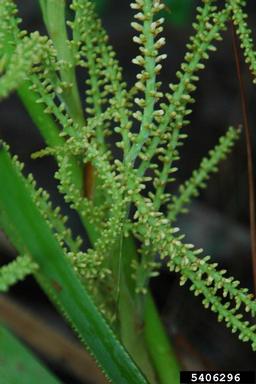
Reproduction
 How
Does Saw Palmetto Reproduce?
How
Does Saw Palmetto Reproduce?
Serenoa repens is an angiosperm. Angiosperms have seeds that are covered. They reproduce in many ways. Serenoa repens produces berries or fruits. Fruit is made from ovarian tissue in a plant and is a key characteristic of an angiosperm. Animals will come and eat the fruit, which are usually out in late summer to early fall, and the fruit contains seed from the plant. Then, when the animal excretes wastes, the seed gets displaced in a new area where it can grow and make a new plant.
Insects often serve as pollinators for this plant, and the flowers usually come out from April until July.
Their seeds do not usually grow very fast and can take up to half a year to germinate. Flooding is often a hindrance to them, and can slow down their life cycle even more.
Picture
above taken by
Karan A. Rawlins,
University of Georgia, Bugwood.org
Angiosperm Life Cycle
Shown below is an angiosperm life cycle that has been redrawn from the Campbell Biology Textbook. This is a typical life cycle for an angiosperm like saw palmetto. We will start our journey at the mature sporophyte flower stage. This is a diploid stage and we will specifically focus on the anther and the ovary. The anther is where the plant makes pollen. Here, microspores are made from microsporophytes in the microsporangium. If we take a look at the ovary we will find that megaspores are made from megasporocytes in the megasporangium. They are made via the process of meiosis.
Once the microspores and megaspores are produced they develop into pollen grains and female gametophytes. Pollination is next for the pollen grains. After this process, the sperm cells from the pollen grain are discharged into the ovary where they will meet the egg. What takes place next is called double fertilization. This produces a zygote, and an endosperm.
After the zygote is made it becomes an embryo. The embryo is put into a seed and eventually the seed will germinate and form a mature sporophyte and the whole process will start over again.
I hope you now know more about Serenoa repens than before you began to read my page.
I did not know or come up with all of this stuff on my own!
Please take a look at the references to see where I got all of my information!
Do you want to go back to the
main page?